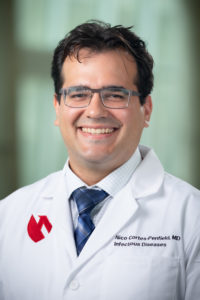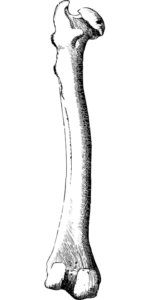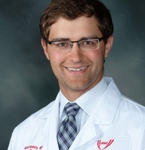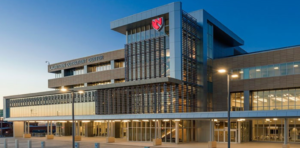New UNMC ID publication alert! #ReadUNMCID
 Recently, the newest member of our Division of Infectious Diseases at UNMC/Nebraska Medicine, Dr. Nicolas Cortes-Penfield published an invited review in Open Forum Infectious Diseases entitled: The History of Antibiotic Treatment of Osteomyelitis. Dr. Cortes-Penfield wrote this summary describing the review article, which was commissioned after he published a comprehensive blog post (on his blog IDJournalClub.com) about the history of osteomyelitis, with a robust twitter response to the topic.
Recently, the newest member of our Division of Infectious Diseases at UNMC/Nebraska Medicine, Dr. Nicolas Cortes-Penfield published an invited review in Open Forum Infectious Diseases entitled: The History of Antibiotic Treatment of Osteomyelitis. Dr. Cortes-Penfield wrote this summary describing the review article, which was commissioned after he published a comprehensive blog post (on his blog IDJournalClub.com) about the history of osteomyelitis, with a robust twitter response to the topic.
What is the study about?
The impetus for this study was the recently published OVIVA trial, which showed equivalent outcomes with oral versus intravenous antibitoics for bone and joint infections. This was a large and really well-designed randomized clinical trial – in our minds, one of the best clinical trials ever published in bone and joint infection research. Yet, we observed that many infectious disease specialists did not feel that OVIVA represented enough evidence to change the way they treat these infections. So we asked ourselves, “What exactly is the quality of the evidence for the way we’ve been doing things?”
In our study, we laid out some of the most commonly taught tenets of treating bone infections (osteomyelitis) and then conducted a narrative historical literature review reaching back to the beginning of the antibiotic era to try to tease out where these teachings came from and which ones were backed by high quality evidence (like clinical trials) versus simply expert opinion and tradition.
What did the study find?
As we reviewed the literature, we focused on three classical teaching points for osteomyelitis: that certain antibiotics are better for these infections because they concentrate in the bones, that intravenous antibiotics give better results than antibiotics given by mouth, and that osteomyelitis needs to be treated with antibiotics for four to six weeks.
We found that the research on antibiotic bone penetration was heterogenous, and that with the exception of the penicillins and cephalosporins there wasn’t compelling evidence that the antibiotic classes achieve different concentrations in bone. Moreover, the studies that generated the theory that antibiotics with better bone penetration treated osteomyelitis more effectively were done in animals; we could not find any robust data in people to support this notion.
 As for the universal necessity of giving antibiotics intravenously for osteomyelitis, we were surprised to find that many of the first reports of antibiotic treatment of bone and joint infections used oral penicillins and other agents, with excellent results. Moreover, when retrospective studies and prospective clinical trials compared specific antibiotics head-to-head, the patients given antibiotics by mouth did just as well as those who received antibiotics intravenously. This was true of multiple studies including both children and adults, and is important because it shows us that the OVIVA study is not the outlier in this body of literature, but rather an extension of what the preponderance of data in people has been telling us all along.
As for the universal necessity of giving antibiotics intravenously for osteomyelitis, we were surprised to find that many of the first reports of antibiotic treatment of bone and joint infections used oral penicillins and other agents, with excellent results. Moreover, when retrospective studies and prospective clinical trials compared specific antibiotics head-to-head, the patients given antibiotics by mouth did just as well as those who received antibiotics intravenously. This was true of multiple studies including both children and adults, and is important because it shows us that the OVIVA study is not the outlier in this body of literature, but rather an extension of what the preponderance of data in people has been telling us all along.
As for the necessary duration of therapy in osteomyelitis, we were surprised by how little evidence we could turn up on this topic. Again, physicians in those earliest reports often used just a couple of weeks of therapy, and most often let their patients’ conditions (e.g. the presence of fever) guide the duration of antibiotic treatment. As best we could determine, a chart study of bone and joint infections published in the New England Journal of Medicine, in which the authors reviewed 62 osteomyelitis cases at their hospital to conclude that patients who received at least a month of antibiotics were more likely to respond well to treatment, seems to have originated what is a now universal dogma. In fact, we located more recent data showing that children with acute osteomyelitis do well with less than three weeks of antibiotic treatment, as well as studies suggest that eight or more weeks of therapy may be better for adults with osteomyelitis and certain high-risk features like ESRD, infection with Methicillin-Resistant Staphylococcus aureus, and undrained paravertebral abscess. So, what we can say with confidence is that this question hasn’t been adequately studied, and how long a course of antibiotics a patient needs probably depends on who they are.
Why is this study interesting?
 This study lays bare the scarcity of data on which several of our current traditions regarding treating osteomyelitis are based. Medicine is a field with a lot of cultural inertia – which makes sense, in that when you’re making high-stakes decision there’s a natural bias to keep doing what you’ve seen work before and what your mentors told you worked best for them. So, in order for us as a medical community to embrace evidence-based medicine, we need more than just better clinical science; we need a shift away from reliance on tradition and deference to hierarchies of eminence (i.e.; “That’s always how we’ve done it here”) and toward a culture of skepticism and interrogation of clinical pearls that don’t come with references cited. We hope this study – whose narrative structure we intended to help the reader grasp the humble origins of some of the clinical dictums they were taught – will do a little to shift the infectious diseases community toward a culture of evidence-based medicine.
This study lays bare the scarcity of data on which several of our current traditions regarding treating osteomyelitis are based. Medicine is a field with a lot of cultural inertia – which makes sense, in that when you’re making high-stakes decision there’s a natural bias to keep doing what you’ve seen work before and what your mentors told you worked best for them. So, in order for us as a medical community to embrace evidence-based medicine, we need more than just better clinical science; we need a shift away from reliance on tradition and deference to hierarchies of eminence (i.e.; “That’s always how we’ve done it here”) and toward a culture of skepticism and interrogation of clinical pearls that don’t come with references cited. We hope this study – whose narrative structure we intended to help the reader grasp the humble origins of some of the clinical dictums they were taught – will do a little to shift the infectious diseases community toward a culture of evidence-based medicine.
What about future research questions?
We could answer this question two ways. First, with the field of osteomyelitis, some obvious next questions are whether certain antibiotic combinations might be more effective at achieving clinical cure without recurrence (i.e.; the use of adjunctive rifampin, currently undergoing a large randomized controlled trial) and what patient and infection factors identify people with osteomyelitis who will do just as well with less than four weeks of antibiotic therapy, or conversely who would really benefit from longer than six weeks of antibiotics. Second, there are plenty of other infections with current standards of treatment based in expert opinion that would benefit from the historical narrative review treatment.

 Recently, several members of the Division of Infectious Diseases at UNMC/Nebraska Medicine published a study in American Journal of Infection Control (AJIC) entitled: Microbial colonization of intravascular catheter connectors in hospitalized patients. Drs. Richard Hankins (former ID fellow, class of 2019), and Kelly Cawcutt (Associate Medical Director of Infection Control) are the lead and senior authors on this study. Dr. Hankins wrote this summary describing their study.
Recently, several members of the Division of Infectious Diseases at UNMC/Nebraska Medicine published a study in American Journal of Infection Control (AJIC) entitled: Microbial colonization of intravascular catheter connectors in hospitalized patients. Drs. Richard Hankins (former ID fellow, class of 2019), and Kelly Cawcutt (Associate Medical Director of Infection Control) are the lead and senior authors on this study. Dr. Hankins wrote this summary describing their study.
 As we get further into the summer, we are yet again nearing West Nile Virus season, and there are starting to be a few cases reported nationwide. Our senior ID fellow Dr. Lindsey Rearigh wrote an article outlining what to expect with West Nile Virus, how it is transmitted, diagnosed, and treated.
As we get further into the summer, we are yet again nearing West Nile Virus season, and there are starting to be a few cases reported nationwide. Our senior ID fellow Dr. Lindsey Rearigh wrote an article outlining what to expect with West Nile Virus, how it is transmitted, diagnosed, and treated. 
 Methicillin-resistant Staphyloccous aureus (MRSA) (photo credit: CDC Public Health Image Library) is a bacteria that can cause a wide variety of infections, including skin or soft tissue infections and bloodstream infections (bacteremia). The Centers for Disease Control (CDC) categorize MRSA as a serious threat (1). Although vancomycin has been a reliable antibiotic to treat MRSA for decades, severe infections from it are still difficult to cure. Current MRSA bacteremia practice guidelines by the Infectious Disease Society of America (IDSA) recommend the use of vancomycin or daptomycin as first-line treatment options for bacteremia (2). Concern arises, however, when bacteremia continues despite the use of these agents. IDSA defines persistent MRSA bacteremia as blood cultures that remain positive after 7 days of effective therapy (2). A study conducted by Cosgrove et al found mortality rates as high as 60% from MRSA bacteremia. Changes in therapy or combination therapy may be necessary despite the limited data (3).
Methicillin-resistant Staphyloccous aureus (MRSA) (photo credit: CDC Public Health Image Library) is a bacteria that can cause a wide variety of infections, including skin or soft tissue infections and bloodstream infections (bacteremia). The Centers for Disease Control (CDC) categorize MRSA as a serious threat (1). Although vancomycin has been a reliable antibiotic to treat MRSA for decades, severe infections from it are still difficult to cure. Current MRSA bacteremia practice guidelines by the Infectious Disease Society of America (IDSA) recommend the use of vancomycin or daptomycin as first-line treatment options for bacteremia (2). Concern arises, however, when bacteremia continues despite the use of these agents. IDSA defines persistent MRSA bacteremia as blood cultures that remain positive after 7 days of effective therapy (2). A study conducted by Cosgrove et al found mortality rates as high as 60% from MRSA bacteremia. Changes in therapy or combination therapy may be necessary despite the limited data (3).
Recent Comments